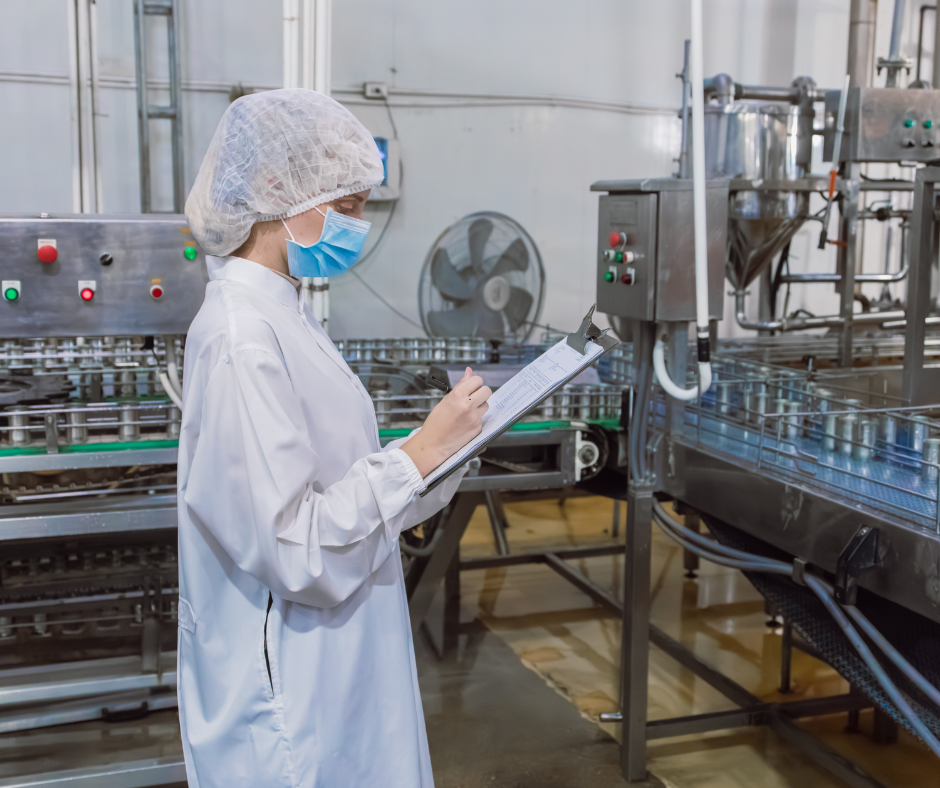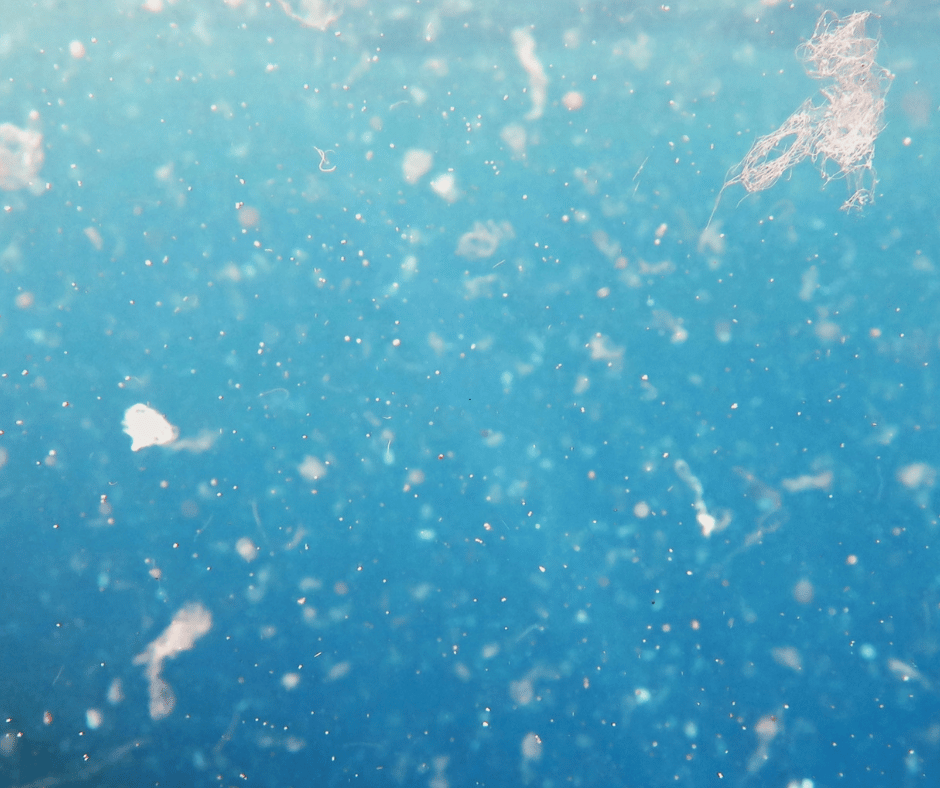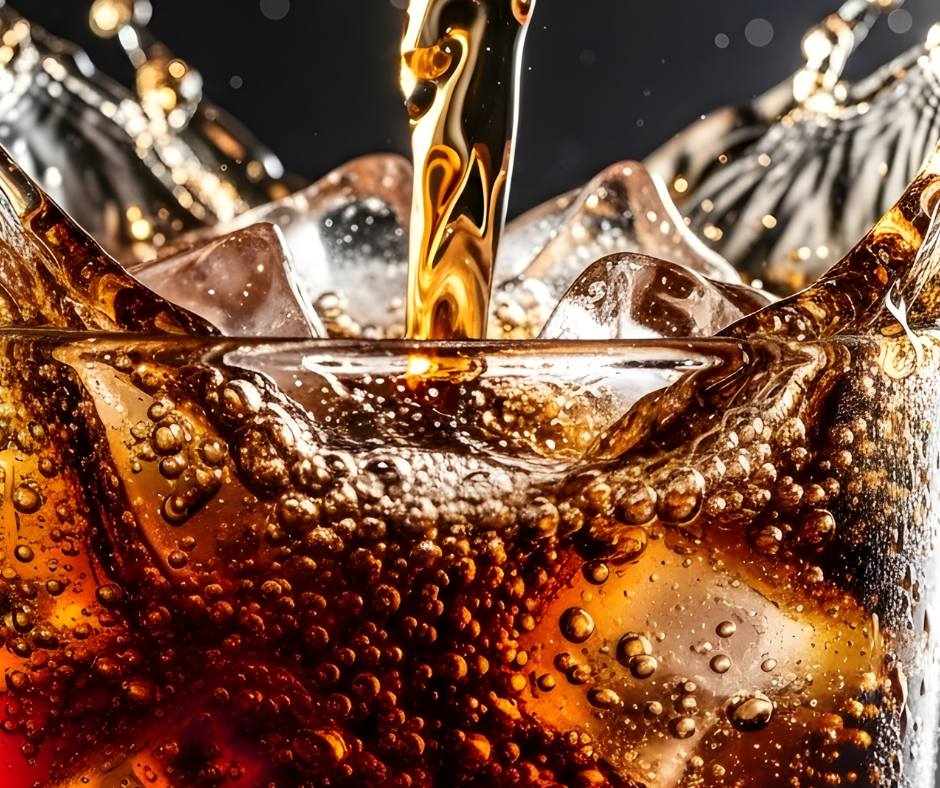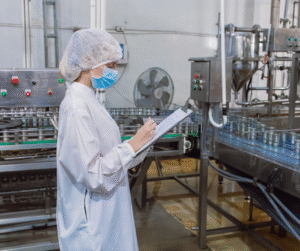What is carbon dioxide used for in the drinks industry, and why does it matter so much to how your product tastes, performs, and sells?
From the fizz in your favourite soft drink to the smooth pour of a draught pint, carbon dioxide (CO₂) plays a vital role at nearly every stage of drinks production and service. It’s not just about bubbles. CO₂ is essential for carbonation, preservation, dispensing, and even cleaning. Whether you’re working in a bottling plant, brewery, fast-food outlet, or behind a bar, you’re relying on CO₂ every day.
In this blog, we’ll explore how carbon dioxide is used in drinks — and why the purity and handling of that gas is critical to quality, safety, and customer satisfaction.
You’ll discover:
- How CO₂ is used to carbonate fizzy drinks, beer, cider, and sparkling wine
- Why it’s essential in post-mix systems and draught drink dispensing
- How it helps preserve shelf life and flavour during packaging
- The role of CO₂ in flushing lines and preventing contamination
- Why gas filtration matters — and how Sure Purity supports beverage quality
This guide is written for beverage manufacturers, quality assurance teams, and hospitality professionals who want to understand not just what CO₂ does — but how to make it work better for their drinks business.
What is Carbon Dioxide and Why Is It Used in Beverages?
Carbon dioxide (CO₂) is a naturally occurring, colourless, odourless gas that plays a critical role in the drinks industry. From adding bubbles to soft drinks to preserving beer in a keg, CO₂ is used in multiple ways.
What makes CO₂ so valuable? Its physical properties. It dissolves easily in liquid under pressure, which is the key to creating carbonation. It’s also inert, meaning it doesn’t react with most ingredients. That makes it ideal for preserving freshness and displacing oxygen, which causes spoilage.
Here’s why CO₂ is widely used in beverages:
- It’s cost-effective and readily available
- It creates the fizz in carbonated drinks, cider, beer, and sparkling wine
- It extends shelf life by keeping oxygen out of bottles and cans
- It’s food-safe when produced and handled to recognised standards
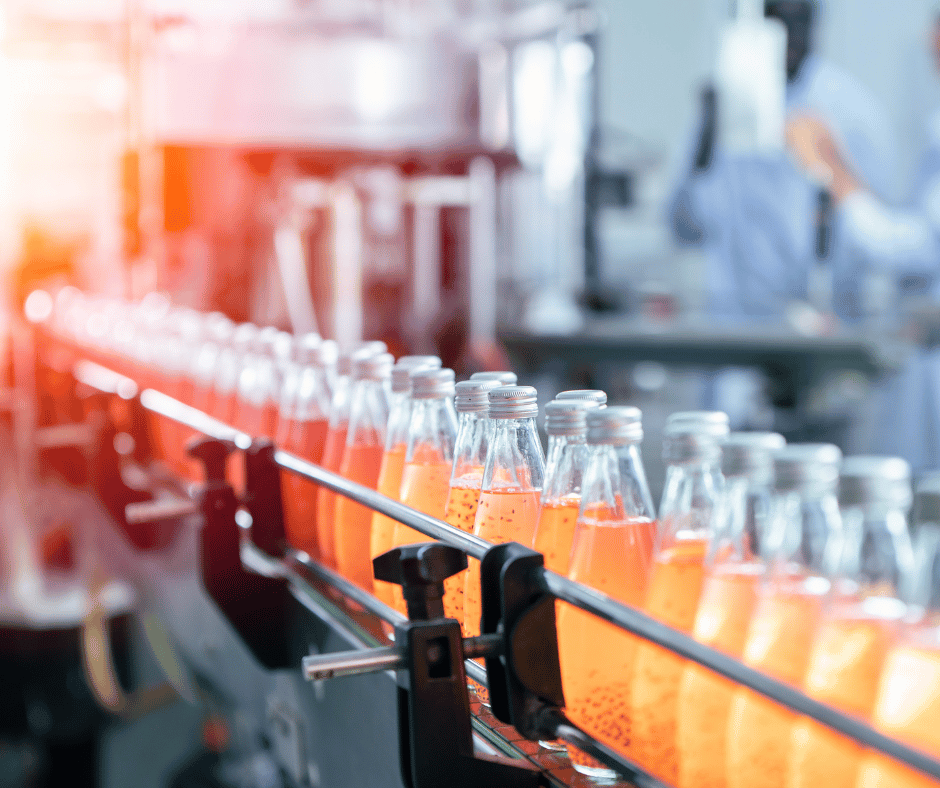
In commercial drinks production, only food-grade CO₂ should be used — typically produced to EIGA or ISBT specifications. These standards ensure the gas is free from contaminants like benzene, sulphur compounds, or methanol, all of which can compromise flavour and safety.
If you’re involved in beverage manufacturing or service, understanding what carbon dioxide is used for in drinks (and ensuring your CO₂ meets strict purity standards) is essential to maintaining quality and consumer trust.
How CO₂ Is Added to Drinks
Carbonation is the process of dissolving carbon dioxide (CO₂) into a liquid under pressure to create a fizzy, sparkling effect. It’s one of the most recognisable and desired characteristics in soft drinks, beer, cider, and sparkling wine.
In beverage production, carbonation is usually done by injecting CO₂ into the liquid in a sealed system. Under pressure, CO₂ dissolves into the drink — and when the pressure is released (as the drink is opened or poured), the gas escapes in the form of bubbles.
This process is explained by Henry’s Law. A scientific principle stating that the amount of gas that dissolves in a liquid is directly related to the pressure of that gas above the liquid. The higher the pressure, the more CO₂ the liquid can absorb.
There are two main types of carbonation used in the drinks industry:
- Forced carbonation: Common in soft drink bottling plants and commercial breweries. CO₂ is injected directly into chilled liquid under pressure, allowing for consistent control over carbonation levels.
- Natural carbonation: Seen in traditional brewing, where CO₂ is produced by fermentation. Yeast consumes sugars and releases CO₂, which becomes trapped in the bottle or keg to carbonate the beverage.
This carbonation process is one of the core carbon dioxide applications in beverage production, and it must be handled with precision. Poorly carbonated drinks feel flat. Over-carbonated drinks can foam excessively or burst packaging. That’s why manufacturers rely on accurate co2 measurements and clean, high quality co2 purity grades for consistent results.
Key Uses of CO₂ in the Drinks Industry
Carbon dioxide plays multiple roles across commercial beverage production and service — from carbonation to packaging and dispense. For manufacturers, brewers, and hospitality operators, understanding each use case helps ensure product consistency, safety, and customer satisfaction. Below, we explore how CO₂ is applied across different sectors and why gas quality matters.
High-Speed Carbonation for Bottling Plants and Soft Drink Manufacturers
In large-scale soft drink production, CO₂ is used to carbonate everything from colas and mixers to flavoured waters and energy drinks. This is done via in-line carbonation systems, which inject CO₂ into chilled liquid under pressure before filling bottles or cans.
Maintaining consistent carbonation volumes is critical to meeting brand specifications. Even minor variations can affect mouthfeel, foaming, and perceived freshness.
Citrus-based and sweetened drinks are especially sensitive to gas purity — trace contaminants can alter acidity or create off-flavours. That’s why many bottling facilities rely on Carboguard to filter CO₂ at the point of entry. This protects both product integrity and flavour stability at scale.
Controlled Carbonation in Breweries and Cider Production
Commercial breweries use CO₂ for forced carbonation, injecting it into conditioning tanks or kegs to achieve desired fizz and mouthfeel. Even in traditional or craft settings where natural carbonation is used, CO₂ is still vital for purging tanks, transferring beer, and inerting packaging.
Poor gas quality or inconsistent pressure can impact:
- Foam retention (head quality)
- Aroma delivery
- Perceived freshness and mouthfeel
Sure Purity works with breweries of all sizes, offering in-line CO₂ filtration that removes contaminants like sulphur or benzene. This safeguards quality from fermentation tank to final pour. Whether you’re producing lagers, IPAs, or cider.
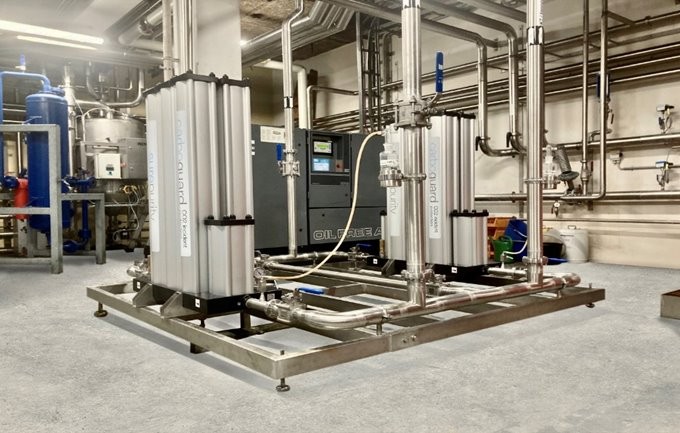
Sparkling Wines, RTDs, and Pressurised Cocktail Products
Canned cocktails, spritzes, and sparkling wine products rely on precise carbonation to deliver a smooth, consistent finish. These are often low-volume, high-margin lines — meaning quality issues can be costly.
Many of these drinks contain botanicals, alcohols, or fruit acids that are highly reactive to CO₂ impurities. Without filtration, taints or off-aromas can develop, risking failed QA checks and customer complaints.
Sure Purity’s filtration systems ensure the CO₂ used in these lines is clean, compliant, and inert. This helps QA teams meet food safety thresholds while maintaining the sensory quality of premium sparkling products.
On-Tap and Post-Mix Dispensing in Hospitality & Fast-Food Chains
In pubs, bars, cafés and QSRs, CO₂ is used to both carbonate and push beverages through draught and post-mix dispensing systems. Here, gas quality is directly linked to the look, taste, and customer experience of every pour.
Flat pints, poor head retention, or dull-tasting cola can all result from contaminated or inconsistent gas supply. Smaller systems are particularly vulnerable, as they rely on cylinders or blended gases, often without filtration.
The Carboguard Mini is designed for these environments. Compact and easy to install, it ensures that only food-grade, filtered CO₂ enters the drink system — helping hospitality teams deliver reliable, high-quality drinks at volume.
Preserving Freshness in Beverage Packaging and Canning Lines
CO₂ doesn’t just add fizz — it also protects flavour. During packaging, CO₂ is often used to purge oxygen from bottles or cans before filling, a process known as inerting. This reduces oxidation, extends shelf life, and preserves sensory quality.
However, if the CO₂ contains impurities, the inerting process can backfire — introducing taints or accelerating spoilage.
Filtration ensures only clean, food-grade CO₂ is used in packaging environments. This is essential in high-volume canning lines, PET bottling, and sealed packaging systems where shelf life and flavour stability are a priority.
Beverage Dispensing in Hospitality and Retail
In pubs, bars, and fast-food outlets, CO₂ is used to dispense and maintain carbonation in soft drinks and draught beverages. It pressurises the system and preserves fizz from keg to glass. Smaller post-mix setups are particularly vulnerable to gas contamination. The Carboguard Mini ensures clean, filtered CO₂ in compact environments, helping maintain drink quality and customer satisfaction.
Preservation and Shelf Life Extension
CO₂ helps extend shelf life by replacing oxygen in bottles and cans before sealing — a process called inerting. This prevents oxidation, spoilage, and off-flavours, especially in sensitive or long-life beverages. Clean CO₂ is essential for this protective step, ensuring flavour is locked in from production to pour.
Chilling and Glass Frosting
CO₂ in solid form — dry ice — is often used in bars to chill drinks quickly or frost glassware for presentation. It adds a visual and sensory appeal, especially in cocktails and high-end drinks service. This use highlights CO₂’s versatility beyond carbonation, contributing to experience as well as function.
Cleaning, Flushing and Line Maintenance
CO₂ is also used to purge and flush beverage lines, especially between production runs or during system maintenance. It helps keep pipelines free from contaminants and oxygen exposure. However, using impure CO₂ during this process can reintroduce unwanted residues — making filtration critical to hygienic line cleaning.
Measuring and Monitoring CO₂ in Drinks
Accurately measuring CO₂ levels is essential in beverage production. Not just for quality control, but for consistency, safety, and product performance. Whether bottling soft drinks or conditioning beer, knowing exactly how much carbon dioxide is dissolved in the liquid ensures the drink delivers the expected taste, texture, and shelf life.
How CO₂ Is Measured in Drinks
Common measurement methods include:
- Volume-based tests – calculating the amount of CO₂ (in volumes or g/L) dissolved in a beverage
- Pressure and temperature readings – using known values and reference charts to estimate carbonation levels
- Infrared (IR) spectroscopy – a non-destructive method that analyses CO₂ concentration by detecting how it absorbs infrared light
- Multiple volume expansion (MVE) systems – used in labs to release and quantify dissolved gas through expansion
Many producers apply Henry’s Law when measuring carbonation, ensuring pressure and temperature are in equilibrium so results are accurate and repeatable.
Why Accurate CO₂ Monitoring Matters
CO₂ levels affect:
- Mouthfeel and foam retention
- Product compliance and labelling (e.g. ABV or carbonation content)
- Taste stability over time
Factors like sample preparation, product composition, and ambient conditions can all influence readings. So regular calibration and controlled conditions are key.
For producers that rely on precise carbonation, monitoring is only half the story — the purity of the co2 entering the system is just as important. Using filtered, food-grade CO₂ helps ensure the levels being measured are delivering clean, consistent results from batch to batch.
Risks of Poor-Quality CO₂ and Contamination
Not all CO₂ used in the drinks industry is created equal. If the gas isn’t properly filtered or fails to meet food-grade standards, it can introduce harmful contaminants directly into the beverage — with serious consequences for taste, safety, and compliance.
What Contaminants Can Be Present in CO₂?
Poor-quality CO₂ can contain trace amounts of:
- Benzene – a known carcinogen with a sweet, chemical odour
- Methanol – toxic even in small quantities
- Sulphur compounds – which produce rotten-egg aromas and alter flavour profiles
- Oily residues or hydrocarbons – which affect foam retention and mouthfeel
Even in parts-per-billion concentrations, these impurities can cause failed safety checks, product recalls, or serious brand damage.
Why CO₂ Filtration Is Critical
Contaminants are often introduced during gas production, storage, or transport. Without in-line filtration, they can pass unnoticed into bottling lines, carbonators, or draught systems, directly affecting the final drink.
Sure Purity offers two filtration solutions tailored to the drinks industry:
- Carboguard – for bottling plants, breweries, and high-volume production lines
- Carboguard Mini – for hospitality venues, fast-food chains, and small-scale dispensing systems
Both systems are designed to remove contaminants at the point of use, delivering clean CO₂ for beverages and protecting the integrity of your product. For drinks manufacturers and hospitality providers alike, CO₂ filtration isn’t just good practice. It is essential for regulatory compliance, taste consistency, and consumer trust.
CO₂ in Fast Food, Bars, and Catering
In the hospitality sector, CO₂ is essential for post-mix drinks, draught systems, and back-of-house operations. Fast-food chains, bars, and catering providers all rely on it to carbonate drinks on demand, dispense beverages quickly, and maintain taste consistency across high volumes.
Post-mix systems mix flavoured syrup with chilled carbonated water at the point of service. CO₂ is used to both carbonate the water and push the drink through the system. If the gas is impure, it can affect flavour, fizz retention, and customer perception — particularly in sweet or citrus-based drinks.
That’s where our Carboguard Mini comes in. It’s designed for compact systems in fast-paced environments, filtering out contaminants like benzene or sulphur compounds before they reach the dispenser.
The benefits for hospitality operators include:
- Consistent taste and carbonation across every pour
- Reduced product waste caused by poor-quality gas
- Improved customer satisfaction and fewer complaints at the counter
For fast food and catering operations that prioritise speed, consistency, and reputation, clean CO₂ is just as important as the drinks being served.
Environmental and Safety Considerations
CO₂ used in the drinks industry can come from various sources — including natural wells, fermentation processes, or as a byproduct of industrial activity. While the gas itself is essential for carbonation and preservation, how it’s sourced, handled, and reused matters for both sustainability and safety.
Sourcing and Sustainability
Some beverage producers now use captured CO₂ from fermentation (especially in breweries) to reduce environmental impact. This form of CO₂ recovery lowers reliance on external gas suppliers and helps cut emissions, making it a popular approach in sustainable brewing operations.
Even where CO₂ is purchased, using only the required amount and ensuring it is food-grade helps reduce waste and improve overall efficiency.
Safe Storage and Handling
Whether used in bottling plants or behind the bar, CO₂ must be handled with care. It is stored under high pressure in cylinders, bulk tanks, or pressurised systems — all of which require:
- Secure mounting and ventilation
- Regular inspections for leaks or damage
- Staff training on safe handling and emergency shut-offs
Final Thoughts
CO₂ is more than just the gas that puts bubbles in your drink. It plays a vital role in every stage of beverage production, from carbonating soft drinks and beer to preserving shelf life, dispensing at point of sale, and ensuring hygienic operation behind the scenes.
But for CO₂ to do its job effectively (and safely) it must be clean, consistent, and food-grade. Impurities like benzene, sulphur, or methanol can damage taste, affect safety, and lead to costly compliance failures. That’s why gas quality should never be left to chance.
Key takeaways:
- CO₂ is essential for carbonation, preservation, and post-mix dispensing
- Gas purity directly affects flavour, mouthfeel, aroma, and shelf life
- Contaminants in unfiltered CO₂ can harm product quality and consumer safety
- CO₂ is also used for line purging, inerting, and even dry ice chilling
- Monitoring and filtration are crucial for quality assurance across every system
At Sure Purity, we help drinks manufacturers, breweries, and hospitality providers protect their products with reliable CO₂ filtration solutions. Whether you run a bottling line or a bar, our Carboguard and Carboguard Mini systems ensure the gas entering your drinks is as clean and consistent as the product you’re known for.

